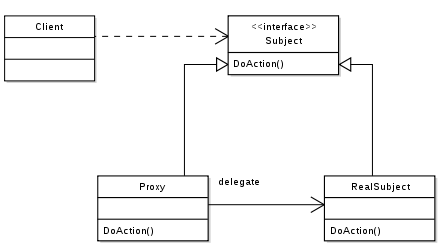You have this class:
class BankAccount
attr_reader :balance
def initialize(starting_balance = 0)
@balance = starting_balance
end
def deposit(amount)
@balance += amount
end
def withdraw(amount)
@balance -= amount
endProbably it is not necessary to explain this code. A simple BankAccount class that it allows to deposit or to withdraw money. However this implementation is very insecure because anybody could remove your money. You should add an authentication mechanism.
A Proxy pattern is used to separate the real object from the client who used it. The objective is append new improvements or functionalities. To do that, is necessary to create a new class who acts like an intermediary.
This pattern can be confused with the Adapter pattern easily. The difference is simple: the Proxy pattern don't modify the original object's behavior like the Adapter pattern, the Proxy pattern only defines how to get access to the original object.
Here a proxy class:
require './bank_account.rb'
class AccountDummyProxy
def initialize(real_account)
@real_account = real_account
end
def balance
@real_account.balance
end
def deposit(amount)
@real_account.deposit(amount)
end
def withdraw(amount)
@real_account.withdraw(amount)
end
endYes, AccountDummyProxy is a dummy class, it works exactly like the original class. But now you can modify this class to add a protection mechanism like this:
require 'etc'
require './bank_account.rb'
class AccountProtectionProxy
def initialize(real_account, owner_name)
@subject = real_account
@owner_name = owner_name
end
def balance
access?
@subject.balance
end
def deposit(amount)
access?
@subject.deposit(amount)
end
def withdraw(amount)
access?
@subject.withdraw(amount)
end
private
def access?
message = "Illegal access: #{Etc.getlogin} cannot access account."
raise message unless Etc.getlogin == @owner_name
end
endCheck out the new difference in this AccountProtectionProxy class is the addition of a method called access?. The class have the real original object (BankAccount) in @subject. This access? check the passsed user name can access to the account, so this method is called before to call each @subject method.
This class is a specific type of Proxy (Protection Proxy). You can define a Virtual Proxy which allows you to have a lazy initialization of the real object:
require './bank_account.rb'
class AccountVirtualProxy
def initialize(starting_balance = 0)
@starting_balance = starting_balance
end
def balance
subject.balance
end
def deposit(amount)
subject.deposit(amount)
end
def withdraw(amount)
subject.withdraw(amount)
end
private
def subject
@subject ||= BankAccount.new(@starting_balance)
end
endThe BankAccount object is not created until is called at the first time when you call public methods like balance or deposit.
Metaprogramming is writing code that writes code.
Sorry, I haven't got the real answer to this. A lot of people love metaprogramming. However many people hate it too.
I think is a good idea to use metaprogramming when you have to code a lot of boring methods that they are very similar between them (Ruby Metaprogramming is even cooler than it sounds).
But it's true that metaprogramming performs slower and it adds some of hidden magic (Avoid using metaprogramming).
Maybe for this case is a better idea not to use metaprogramming but is a good moment to see metaprogramming in action. Here there are two ways.
Method Missing approach:
require 'etc'
require './bank_account.rb'
class AccountProxy
def initialize(owner_name, starting_balance = 0)
@owner_name = owner_name
@starting_balance = starting_balance
end
def method_missing(name, *args, &block)
access?
if subject.respond_to?(name)
subject.public_send(name, *args, &block)
else
super
end
end
def respond_to_missing?(name, include_private = false)
subject.respond_to?(name) || super
end
private
def access?
message = "Illegal access: #{Etc.getlogin} cannot access account."
raise message unless Etc.getlogin == @owner_name
end
def subject
@subject ||= BankAccount.new(@starting_balance)
end
endA good recomendation is define respond_to_missing? too.
The balance or amount methods are not defined. But don't worry. When you call AccountProxy.new.balance is called the AccountProxy#method_missing method where is called explicitily with subject.public_send(method_name,...).
Dynamic Methods approach:
require 'etc'
require './bank_account.rb'
class AccountProxyAlternative
def initialize(owner_name, starting_balance = 0)
@owner_name = owner_name
@starting_balance = starting_balance
subject.public_methods(false).each do |name|
AccountProxyAlternative.define_action(name)
end
end
def self.define_action(name)
define_method(name) do |*args|
access?
subject.send(name, *args)
end
end
private
def access?
message = "Illegal access: #{Etc.getlogin} cannot access account."
raise message unless Etc.getlogin == @owner_name
end
def subject
@subject ||= BankAccount.new(@starting_balance)
end
endIn this case, the balance or amount methods are defined dynamically with define_method method in self.define_action(name) class method.
Both approachs work although...
-
Method missing is more dangerous: if you call a method called
displaywhich already exists (Object#display), this method will never callmethod_missing. To solve this is necessary implement a blank slate object, an object with just a few of necessary methods. In Ruby is enough with inherit the Proxy class fromBasicObject. -
Dynamic methods requiere to know more information: in the previous examples the names of the dynamic methods are defined in
BankAccountclass. But if you did not know the names, you could not define them. -
Method missing is slower: if you already know how works Ruby method lookup you must understand why this technique performs worse than dynamics methods (a lot of methods calls until to find the wanted method).
So... you should use Dynamic Methods approach when you can and use Method Missing approach when it be the only way.
- Design Patterns in Ruby by Russ Olsen.
- Metaprogramming Ruby 2 by Paolo Perrotta.
Code examples based on examples of Design Patterns in Ruby and Metaprogramming Ruby 2
